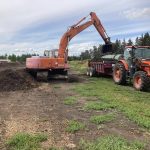RED DEER – A drilling crew is working on a gas well and within days the neighbouring farm well loses pressure or the water starts to stink.
The first reaction is likely to blame the energy company but hydrogeologist Alec Blyth of the Alberta Research Council says that might not be justified.
Blyth told the Synergy Alberta convention in Red Deer Oct. 28 that drilling and fracturing in the subsurface can affect water quantity and quality, but there are other causes as well.
He said Alberta typically has thick layers of shale between aquifers that make adverse impacts unlikely except in rare situations.
Read Also

Canola council cuts field agronomy team
The Canola Council of Canada is cutting its agronomy team as part of a “refreshed strategic framework.”
Oil and gas wells are not typically completed in the same subsurface region as an aquifer. However, quality problems in the concrete surrounding the well could cause the oil and gas wells to leak into an aquifer.
More likely, he said, problems already exist in a water well that was not developed properly, particularly when screens plug with sediment, bacteria or minerals.
Deterioration in the casing may cause rust or perforations to appear in the screen, causing a loss of water.
“If you go too cheap on your well screen, you can have perforations,” Blyth said.
Minerals blocking the screen may also cause water levels to drop.
Drought is another natural cause of low water levels. It may take two years after a drought for ground water to recharge and replenish an aquifer.
Many users on a single aquifer can also reduce water pressure.
“Many users and natural recharge conditions are a likely source of water level declines,” he said.
Complaints about water quality are common. Gas in the water may occur naturally, but poor cementing on an energy well casing may allow gas to leak.
People also complain that gas may get into the water supply when formations are fractured to release natural gas.
Blyth said this is unlikely to happen because fractures tend to extend horizontally 60 to 100 metres from the well bore. They do not fracture vertically, which would allow gas to escape upward, he added.
Bacteria in the water is a common complaint, but they may be present because the well is in a poor location or it may be too close to a septic system or livestock corral.
Other sources of bacteria are poor seals or lack of well maintenance.
Signs of bacteria include slimy growth in the toilet tank. They can decrease water yield because they plug wells.
Producers may see black scale with a rotten egg smell on plumbing fixtures caused by the presence of iron and sulfur. Bacteria feed off sulfur and iron to produce the slimy material.
“Water in Alberta has a lot of sulfur in it and regularly there is a lot of iron,” he said.
Regular well maintenance may be required once or twice a year. He said adding chlorine to a well may not kill certain bacteria.
Shock chlorination is often used to control iron and sulfate bacteria, fecal coliform and E. coli. It involves replacing all the water in the well as well assome of the water in the surrounding formation with a large volume of chlorinated water. To be effective, it needs to be done early and often as part of a routine maintenance plan.
Sediments in water are another complaint often blamed on the migration of drilling fluids.
“It is unlikely to cause trouble, but there are extenuating circumstances where it can,” Blyth said.
Improperly plugged seismic shot holes can be a direct path for contamination to reach ground water. The holes are 15 to 18 metres deep and are sealed with a plastic plug to a depth of not less than one metre below ground level. The plug is followed by bentonite pellets and firmly tamped borehole cuttings placed progressively closer to the surface.

















